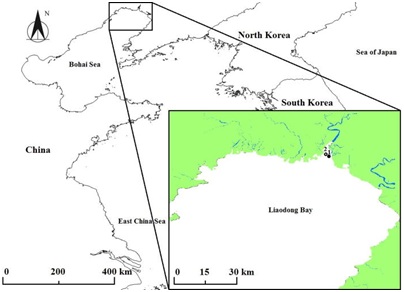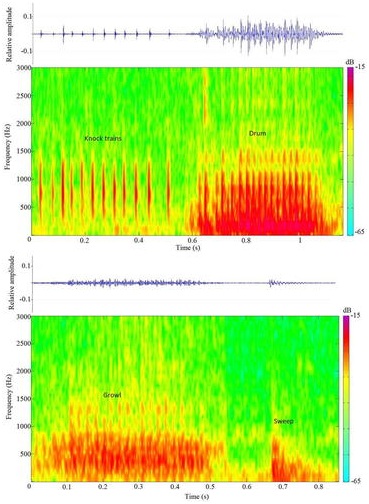Classification of Underwater Vocalizations of Wild Spotted Seals (Phoca largha) in Liaodong Bay, China
The research articleClassification of Underwater Vocalizations of Wild Spotted Seals (Phoca largha) in Liaodong Bay, China written by Prof. Xiaomei Xu and her doctoral candidate Liangliang Yang has been published online in The Journal of the Acoustical Society of America on March 31, 2017.
Abstract: Underwater vocalizations were recorded and classified from wild spotted seals (Phoca largha) in Liaodong Bay, China. The spotted seals exhibited an extensive underwater vocal repertoire but with limited complexity. Four major call types, representing 77.8% of all calls recorded, were identified using multivariate analyses of ten acoustic parameters; knock, growl, drum, and sweep. The calls were relatively brief (12–270 ms, mean of -10 dB duration) pulsating sounds of low-frequency (peak frequency <600Hz ) and narrow bandwidth (169–232 hz, mean of -3 db bandwidth; 237–435 hz, mean of -6 db bandwidth). frequency variables (-3/-6 db frequency bandwidth, center frequency, and top three peak frequencies) were the primary descriptors used to differentiate the call types. comparing the spotted seal underwater vocalizations with those of the closely related pacific harbor seal (Phoca vitulina richardii) indicated that the two species use similar bandwidths and peak frequencies but spotted seal calls were generally shorter. Knowledge of underwater vocalizations of wild spotted seals is important for understanding the species behavior and for planning future acoustic surveys of its distribution and occurrence.

FIG. 1. (Color online) Map showing the morning (1, solid dot) and evening (2, circle) locations where spotted seal (Phoca largha) underwater vocalizations were recorded in Liao River estuary, in Liaodong Bay, China.


FIG. 2. (Color online) Oscillogram (a) with signal envelope (dotted line) and average energy spectrum (b) examples of spotted seals (Phoca largha) underwater vocalizations recorded in Liaodong Bay, China, showing the vocal parameters measured for acoustic description and definition of the calls: -10 dB duration (τ-10dB ), positive start-up time of oscillation (τPSO ) and negative start-up time of oscillation (τNSO ), top three peak frequencies (PF1, PF2, and PF3), center frequency (CF), -3 dB frequency bandwidth (-3 dB_BW), and -6 dB frequency bandwidth (-6 dB_BW). PF1 and PF2 represent two extreme amplitude points in the -3 dB bandwidth (NumE).

FIG. 3. (Color online) A dendrogram of the underwater vocalizations recorded from spotted seals (Phoca largha) based on hierarchical cluster analysis. Different main clusters (similarity over 95%) are shown in different colors. 704 observations (calls) were analyzed and 548 of these (77.8%) were identified as four different call types (knock, growl, drum, and sweep).

FIG. 4. (Color online) Oscillograms (above) and spectrograms (below, sampling rate 80kHz, hamming window, FFT size = 1024 points, frequency overlap = 50%) of four underwater call types, knock, growl, drum and sweep, identified from recordings of spotted seals (Phoca largha) in Liaodong Bay, China.
Citation:Liangliang Yang, Xiaomei, Xu, Peijun Zhang, Jiabo Han, Bing Li, Per Berggren. Classification of underwater vocalizations of wild spotted seals (Phoca largha) in Liaodong Bay, China. The Journal of the Acoustical Society of America, 2017, 141(3):2256-2262
Link to full text:http://asa.scitation.org/doi/10.1121/1.4979056
